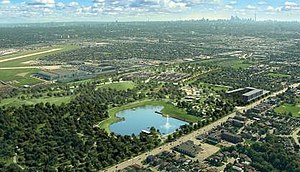KIA Training Ground
| Downsview Park | |
|---|---|

Illustration of Toronto's Downsview Park future redevelopment plan
|
|
| Location | Toronto, Ontario, Canada |
| Coordinates | 43°45′25″N 79°28′44″W / 43.75694°N 79.47889°WCoordinates: 43°45′25″N 79°28′44″W / 43.75694°N 79.47889°W |
| Area | 2.4 km2 (0.93 sq mi) |
| Established | 1998 |
| Governing body | Canada Lands Company |
| Website | www |
Downsview Park (French: Parc Downsview) is a federally owned and managed park located in the Downsview area of North York, Toronto. The park was first home to de Havilland Canada, an aircraft manufacturer, and later was a Canadian Forces Base. In 1999, the Government of Canada declared it as "Canada's first urban national park." As of 2014[update], little development took place, and the park remains mostly untouched.
The area was first used in 1929 by de Havilland Canada, where it housed the company's Canadian operations. The manufacturing plant was used to make aircraft during World War II. After the war, the Department of National Defence (Canada) needed space to station Royal Canadian Air Force squadrons in the area. In 1947, the federal government acquired and consolidated 270 properties in Downsview surrounding the manufacturing plant.
In 1999, the federal government announced, to great fanfare, that the park would become "Canada's first urban national park." Downsview Park announced an International Design Competition. In 2000, Bruce Mau and Rem Koolhaas submitted the winning design scheme, known as "Tree City." In the years that followed, little development took place, and the plans fell into dormancy.
Instead of creating a park made up of almost entirely green space as called for in the "Tree City" plan, Parc Downsview Park Inc., the crown corporation then in control of the park, approved constructing commercial and residential developments across the north, east and southwest ends of the park.
The initial phase of the construction of Downsview Park began in 2005. The first step was to regenerate the soil, which had been compacted by more than 50 years of military base use, so that it will again support the lush vegetation that is planned for a very significant portion of the site. A major feature of this initial work was the development of the Canada Forest, which was started with a partnership with Natural Resources Canada and its 2020 Fast Forest initiative.
...
Wikipedia

